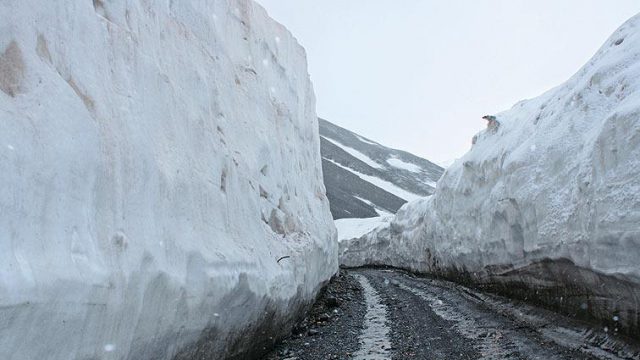The 434-km Srinagar-Leh road would help us avoid altitude sickness (almost inevitable, we were told, if we landed in Leh by flight, straight from Delhi). More affordable, too, since the summer airfares are so high that we could have flown all the way to Bangkok in half the price. So it was that we asked Cox & Kings to take care of all our arrangements, and a brand new Xylo awaited us on a beautiful Srinagar morning. One last look at our elegant Gurkha Houseboat (welcomheritagehotels.com), moored on the other shore of the tranquil Nigeen Lake and we were off on the adventure of our mostly urban lifetime.
Nisar, our driver on the first stretch, said very little but managed to keep us punctual. He gave us a good hour-and-a-half at Sonmarg (a couple of hours out of Srinagar and, normally, a day-trip), where we avoided the tourist-glutted pony trail, and hiked a bit up an expansive meadow to take a closer look at the Thajiwas Glacier, the most notable ‘sight’ in this extraordinarily picturesque valley. It was going to be a day of superlatives but we didn’t know it yet.
My family and I don’t profess to be roadies but the mindblowing-ness of NH-1D made even our notoriously motion-sick younger child forget her troubles. The ‘highway’ may get frequently scrunched to a single-lane of wet rubble but it’s a massive tribute to the Border Roads Organisation that they have such a lifeline up and running through some of the most hostile terrain anywhere in the world. The road careens, dips, tumbles and climbs again over icy landscapes literally at arm’s length. A short and steep 9km out of Sonmarg, we ascend the famed Zoji La, which leaves most tourists in fits of delighted laughter at having made it to its snowy heights (out of their toasty cabs, that is). The nearly-ornamental prettiness of the Kashmir Valley falls behind with every slow mile as massive mountainsides of shape-shifting, colour-changing slate and rock take over. There’s a frozen glacier behind every second corner, towering peaks never out of sight, powdery snowflakes and transparent icicles just outside the warm windowpane. How on earth did someone think of building a road here?
We stop for a late lunch at Drass to have piping hot rajma and rice at the second highest inhabited place in the world (Siberia is the first, Wikipedia tells me). A scant half-hour down the road is the War Memorial — no amount of fortification can stop us from shivering and it’s not only because of the cold. Finally, that night, in dusty Kargil’s ‘basic’ Caravan Serai lodge, we find white sheets, clean bathrooms and a sumptuous meal. It is more than we expected.
The following morning, we are sorely tempted by the four-hour detour to the Brokpa villages of Dah and Hanu but we decide to stick to our primary route via Mulbek (prayer flags, quiet monastery and a rock-carved Buddha by the road, our first glimpse of Ladakh’s many Buddhist treasures).
The tranquil gompa of Lamayuru comes next — a visit made all the more memorable by a delicious meal at the restaurant attached to the monastery’s Niranjana Guest House. We also cross Namika La (“the pillar of the sky”) and Fotu La (the highest point on the highway at 13,479ft; Zoji La is at 11,649ft and comes in second) passes in the Zanskar Himalaya. By the time we reach Ule for our second night’s halt, we are deeply grateful for the chance to unwind at the scenic and beautifully kept Ule Ethnic Resort (uleresort.com) — don’t go by the pictures; they don’t do justice to it. This is charming poplar and apricot country, and we gorge on the sun-dried fruit, its jam, juice and preserve.
Indeed, don’t rush forward to Leh on the second day and make sure you get enough time to go whitewater rafting in the Lower Indus at Saspol (Rs 1,500 per person for a 12km stretch). It’s afternoon by the time we leave Ule reluctantly, and now the third day since we left Srinagar. Leh is just 80km away and the road turns broad and smooth as we approach its vast flatland with the light fading for the evening. En route, we have taken in the ancient monastery at Alchi, the haunting ruins of Basgo, the intriguing Magnetic Hill, the Gurudwara Pather Sahib and the Spituk gompa — standard excursions near Leh. We are exhausted and breathless from exhilaration but not altitude sickness. Ladakh has led us gently into its unique magic.
The information
Our Srinagar-Leh road trip was organised by Cox & Kings. We paid about Rs 24,000 per person for 6N/7D, MAP basis, including the ride and customised sightseeing in and around Leh.
The Border Roads Organisation usually throws the snowbound Srinagar-Leh road open in the last week of April and works at keeping it going till mid-October. As some stretches are frighteningly narrow and army vehicles travel in mile-long convoys, civilian cars are let through at 11am on the Sonmarg side and 4am from the Kargil end. Cabs are affiliated to tour operators’ associations in Kargil and Leh so you’ll be asked to switch to another vehicle possibly at Kargil or Ule/Alchi.
J&K Tourism runs a bus service with an overnight halt at Kargil but the vehicles we saw were pretty ramshackle. If you can afford it, opt for your own cab. Photography enthusiasts, sit on the right-hand side. There’s light in the mountains till 7.30pm.




